Solution
In this mode, the shutter stays open as long as you hold down the shutter button completely, and closes when you let go of the shutter button. This photographic technique is called "bulb exposure". Use bulb exposures for night scenes, fireworks, the heavens, and other subjects requiring long exposures.
CAUTION
Do not point the camera toward an intense light source, such as the sun or an intense artificial light source. Doing so may damage the image sensor or the camera’s internal components.
The procedure for bulb shooting is explained below.
1. Set the camera's power switch to <ON>.
2. Set the Mode Dial to <

>.
3. While looking at the LCD panel or the viewfinder, turn the <

> or <

> dial to set the desired aperture.
4. Take the picture.
- The exposure will continue for as long as you keep the shutter button pressed completely.
- The elapsed exposure time (
 ) will be displayed on the LCD panel.
) will be displayed on the LCD panel.
NOTE
- Long bulb exposures produce more noise in the image than usual.
- If ISO Auto is set, ISO 400 will be set.
- When shooting bulb exposures without using the bulb timer, if you use both the self-timer and mirror lockup, keep pressing the shutter button completely (for self-timer delay time + bulb exposure time). If you let go of the shutter button during the self-timer countdown, there will be a shutter-release sound, but no picture will be taken. If you use the bulb timer under the same shooting conditions, you need not keep holding down the shutter button completely.
REFERENCE
- With [
 : Long exp. noise reduction], you can reduce the noise generated during long exposures.
: Long exp. noise reduction], you can reduce the noise generated during long exposures.
- For bulb exposures, using a tripod and bulb timer is recommended. You can also use mirror lockup in combination.
- You can also shoot bulb exposures by using Remote Switch RS-80N3 (sold separately) or Timer Remote Controller TC-80N3 (sold separately).
- You can also use Remote Controller RC-6 (sold separately) or Wireless Remote Control BR-E1 (sold separately) for bulb exposures. When you press the remote controller’s transmit button, the bulb exposure will start immediately or 2 sec. later. Press the button again to stop the bulb exposure.
You can preset the bulb exposure’s exposure time. With the bulb timer, you need not keep holding down the shutter button during the bulb exposure. This reduces camera shake.
The bulb timer can be set only in the <

> (bulb exposure). It cannot be set (or will not function) in any other mode.
The bulb timer setting procedure is explained below.
1. Set the Mode Dial to <

>.
2. Press the <MENU> button to display the menu screen.
3. Press the <

> button and select the [

] tab.
4. Under the [

] tab, select [Bulb timer], then press <

>.
5. Select [Enable], then press the <INFO> button.
7. Select [OK].
- The set time will be displayed on the menu screen.
- When you exit the menu, <
 > will be displayed on the LCD panel.
> will be displayed on the LCD panel.
8. Take the picture.
- Press the shutter button completely, and the bulb exposure will start and continue until the set time elapses.
- During bulb timer shooting, <
 > will blink.
> will blink.
- To cancel the timer setting, set [Disable] in step 5.

: Elapsed exposure time

: Bulb timer
IMPORTANT
- While the bulb timer is operating, if you press the shutter button completely and let go of it, the bulb exposure will stop.
- If you keep pressing the shutter button completely after the exposure starts, the bulb exposure will continue even after the set exposure time elapses. (The bulb exposure will not stop automatically when the set exposure time elapses.)
- If the drive mode is set to <
 > (Self-timer: Continuous), the bulb timer cannot be set.
> (Self-timer: Continuous), the bulb timer cannot be set.
- Doing any of the following will cancel the bulb timer (reverts to [Disable]): Setting the power switch to <OFF>, replacing the battery, replacing the card, switching to movie shooting, or changing the shooting mode to a mode other than <
 >.
>.
Maximum Possible Bulb Time
| Type of Bulb Shooting | Maximum Possible Bulb Time |
| Bulb Shooting | Room Temperature (23°C / 73°F): Approx. 6 hr. 20 min.
Low Temperatures (0°C / 32°F): Approx. 5 hr. 40 min. |
| Bulb Timer Shooting | from 1 sec. to 99 hr. 59 min. 59 sec.
|
 >.
>.
 > or <
> or <  > dial to set the desired aperture.
> dial to set the desired aperture.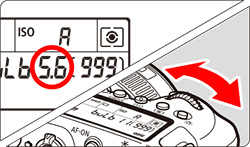

 ) will be displayed on the LCD panel.
) will be displayed on the LCD panel.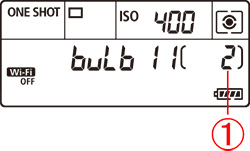
 : Long exp. noise reduction], you can reduce the noise generated during long exposures.
: Long exp. noise reduction], you can reduce the noise generated during long exposures.  > (bulb exposure). It cannot be set (or will not function) in any other mode.
> (bulb exposure). It cannot be set (or will not function) in any other mode. >.
>.
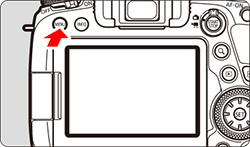
 > button and select the [
> button and select the [  ] tab.
] tab.
 ] tab, select [Bulb timer], then press <
] tab, select [Bulb timer], then press <  >.
>.
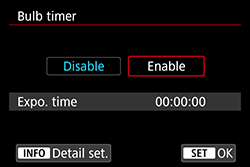

 > so <
> so <  > is displayed.
> is displayed.  >. (Returns to <
>. (Returns to <  >.)
>.)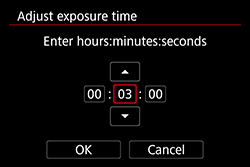
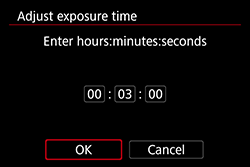
 > will be displayed on the LCD panel.
> will be displayed on the LCD panel. > will blink.
> will blink.  : Elapsed exposure time
: Elapsed exposure time  : Bulb timer
: Bulb timer 
 > (Self-timer: Continuous), the bulb timer cannot be set.
> (Self-timer: Continuous), the bulb timer cannot be set. >.
>.